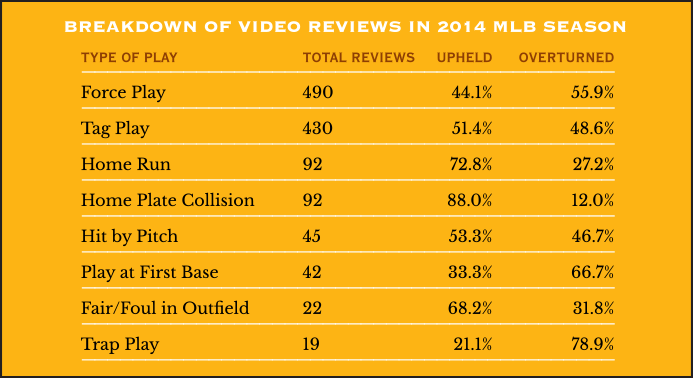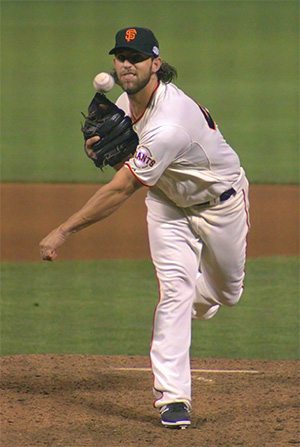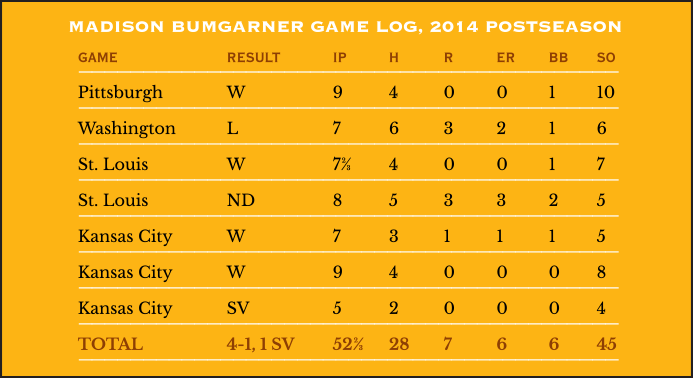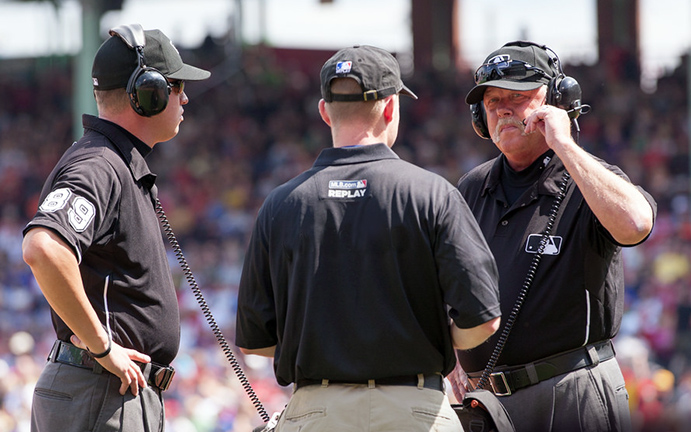THE YEARLY READER
2014: Replay it Again, Bud
Baseball finally embraces extensive video replay to review close calls, but the process leaves a lot to be desired.
Umpire Jim Joyce (right), whose blatant blown call once denied a perfect game and put increased pressure on baseball to expand video replay, connects with the review “war room” back in New York to re-examine a close play during an August game at Boston. (Flickr—Ken Jancef Photography)
The most loyal of Kansas City Royals fans would admit that their first world championship, in 1985, came gift-wrapped in the form of a blatantly blown call, a gaffe clearly exposed to millions of television viewers and, too late to correct himself, umpire Don Denkinger—whose name would go down in infamy as a result.
Nearly three decades later, the Royals returned to the Fall Classic for the first time since the Denkinger Boner and, in the third inning of Game Seven against the San Francisco Giants, the echoes of fortuity began to reverberate again through Kauffman Stadium when, in an attempt to avert a double play, a desperate head-long dive into first base by the Royals’ Eric Hosmer was ruled safe by umpire Eric Cooper.
The play was close—certainly closer than Denkinger’s obvious miss—but replays contradicted Cooper’s initial ruling, narrowly confirming that the ball hit the webbing of Brandon Belt’s glove just before Hosmer got his hands on the bag.
Unlike the St. Louis Cardinals in 1985, the Giants had a source of rebuttal: Video review, instituted in 2014 for the first time on a comprehensive level. San Francisco manager Bruce Bochy challenged the call and asked the umpires to take a second look; after rerunning the play at multiple angles in super-slow motion back at baseball’s video review “war room” in New York, Bochy’s appeal was vindicated. The call was overturned, Hosmer was now declared out, a potential Kansas City rally in a tie game was extinguished, and Cooper avoided going down in notoriety as the next Denkinger.
As television became a dominant player among major sports in the 1960s, the networks enlivened the experience with slow motion replay that often revealed bad officiating. Perhaps it was difficult for fans in the grandstands to see a wrong call made at second base in real time, hundreds of feet away from the action, but it was quite easy to see it up close through a televised zoom lens at a fraction of the original speed. The increased focus on such moments gave birth to a growing voice from fans and columnists who argued: If it’s obvious to us that the call was wrong, why couldn’t it be acknowledged by the officials and changed for the more righteous, right there and then?
In 1986, a year after Denkinger’s legendary blown call, the National Football League became the first major sports circuit to use video review of disputed calls. America’s other major sports leagues soon followed suit—except baseball. For over two decades, Major League Baseball stiff-armed the thought, with commissioner Bud Selig leading the chorus of skepticism with worries that replay would interfere with the integrity of the game and that to err is human—even if it robbed teams of world titles (the 1985 Cardinals) or pitchers of perfect games (Armando Galarraga in 2010).
Early on, Selig did have one legitimate talking point for which to defend his stance: The lack of technological quality and omnipresence, as some major league games still weren’t even being televised. That position began to weaken after the turn of the millennium as hi-def resolution and advanced slow-motion techniques became commonplace—and just as importantly, the emergence of regional networks and MLB’s online streaming market ensured that all games would be broadcast at the highest quality.
Still, baseball resisted—until 2008, when an epidemic of bad calls generated continued bad PR for MLB and forced the sport into embracing video review for the first time. But it proceeded tepidly, allowing only disputed home run calls—fair or foul, over or below the line, interfered with or not—to be eligible for review. Critics assailed MLB for using baby steps, though acknowledging that they were at least steps in the right direction.
Finally, for 2014, Selig announced that baseball would significantly expand video review, allowing virtually all calls outside of balls and strikes to be eligible for a second look. But the devil in the details left many shaking their heads anew.
BTW: Among the scenarios not eligible for review were “neighborhood” plays at second and fair/foul calls within the infield.
Baseball’s video review committee went against popular opinion and decided that the managers, not an impartial crew positioned upstairs or offsite, would be responsible for calling the challenges; it was believed that two of the three committee members, retired Hall-of-Fame managers Tony La Russa and Joe Torre, held too much pride in taking any aspect of decision-making away from their active brethren.
BTW: The third member of the committee was long-time baseball executive John Schuerholz.
But by giving control to the managers and thus exposing the process to possible abuse (such as a frivolous challenge to buy extra bullpen warm-up time for a reliever), the committee had to force a quota on the number of challenges per team, per game to two—and that’s only if the manager was successful on the first challenge. The committee did inject some breathing room (if not sanity) into the system by allowing umpires to call their own reviews from the seventh inning on.
At a cost of $50 million, much of it poured into a central “war room” in New York where replay officials had a plethora of monitors big and small at their disposal, comprehensive video review debuted in 2014. The reaction was far from positive.
Understandably, there would be the inevitable growing pains. One obvious blown call during an early New York Yankees-Boston Red Sox game was surprisingly upheld because the war room officials, with all those monitors, never queued up the smoking-gun angle to review. The separation of the review “umpires” from the ballpark also played a role in occasional confusion, as happened one night at Tampa Bay when they couldn’t even get the correct number of pitches verified after the Rays’ Yunel Escobar had either struck out or walked in a game against Minnesota. The reviewers decided that neither had happened and Escobar next struck out on a 4-2—or 3-3—pitch.
One unexpected and glaring side effect—and one of the replay system’s biggest criticisms—came from the manager emerging from the dugout after a close play and stalling the umpires until his own replay reviewer, perched above in the press box with a monitor, would decide whether the play was worth reviewing. On many occasions, it wasn’t—leaving the manager to retreat back to the dugout, time wasted. By season’s end, MLB claimed that the average length of each of the 1,275 reviews was a little under two minutes—but that didn’t include the roughly one minute spent by the manager dawdling about in limbo as he awaited word from his reviewer upstairs. And as baseball knowingly braced for the impact of video review adding time to an already long contest—another emerging problem it would soon have to tackle—it was disappointed to learn that replay would not cut down on managerial ejections, as skippers continued to bark away and get tossed even after the indisputable evidence was bared for all to see. Sometimes it was done to fire up his team. Other times, it was simply done out of frustration.
BTW: Of the 1,275 replays called, 224 were initiated by the umpires themselves.
After Further Review…
Here’s a breakdown of the results from the eight scenarios most frequently challenged during the first year of comprehensive video review, as listed by baseballsavant.com. Of the 1,275 calls challenged—224 of which were initiated by the umpires themselves—47.8% were overturned.

Warts and all, MLB’s comprehensive review system survived its first season with mixed reviews, with very few outsiders opining that it was the perfect panacea to getting all the calls right. Likely among those preaching to the choir was Joe Torre himself, who admitted after the season that adjustments to the process were sure to follow. But at least baseball had, for the moment, caught up with the rest of the sports world by jumping headlong into the pool of replay technology—for better or for worse.
The 2014 season also affirmed another recent trend: That just because you finished with the league’s best record didn’t mean you’d be the best in October.
The Los Angeles Angels of Anaheim, graced with the game’s best player of the moment (spectacular 22-year-old outfielder Mike Trout) and quality depth within its pitching staff after several years of severe dearth in the department, steamrolled past the Oakland A’s late in the year to take the American League West while securing the league’s number one postseason seed with an excellent 98-64 record. This was all very impressive to the rest of the league, but not intimidating—certainly not to the Angels’ first-round opponent, the upstart Kansas City Royals.
Once upon a time, the Royals were one of baseball’s model franchises, intelligently built from the ground up into a lasting power through shrewd, aggressive talent growth in their minor league system. But small-market reality, exacerbated by the emergence of modern free agency, shook the Royals down into an impoverished, irrelevant major league unit for the long term. The talent was there, and then it wasn’t—as homegrown Royals stars from Johnny Damon to Carlos Beltran to Zack Greinke, among others, were sent away for prospects before the inevitable departure via free agency. It all hit rock bottom in the early 2000s when the Royals became perennial 100-game losers.
Out of the ashes, the Royals in 2006 gave the general manager’s job to former Atlanta scout Dayton Moore, who quickly told the organization to forget free agency—after all, there was no way the Royals could compete at that game on a miniscule budget. Instead, he set out to gain respect just as the team had originally done it: Through the farm system. What followed was a mass build-up of prospects—some via the draft (outfielder Alex Gordon, first baseman Eric Hosmer, third baseman Mike Moustakas), some via dirt-cheap purchases of international talent (catcher Salvador Perez, pitchers Yordano Ventura and Kelvin Herrera)—that turned the Royals’ minor league system into one of the strongest ever recalled. Scouts and experts all agreed: It was no longer a question of whether the future would ever arrive in Kansas City, but when.
Even as many of these blue-chippers graduated from the minors, the Royals continued to lose—and the light at the end of the tunnel just didn’t seem to grow any brighter. Patience became as thin as melting ice under Moore’s feet—in part because Kansas City pitching remained lousy. Moore masterfully corrected the problem in 2013 when he used a surplus of young hitting talent and sent super-prospect Wil Myers to Tampa Bay for veteran ace pitcher James Shields and young fastballer Wade Davis. The Royals responded with their first winning record in 10 years.
The young, talented and hungry Royals were expected to finally break through in 2014 as a number of prognosticators picked them to topple experienced, high-powered and high-priced Detroit in the AL Central. They didn’t, wrapping the regular season a mere game behind the Tigers—but they were good enough to live and fight another day via the wild card.
BTW: Kansas City hurt its divisional title hopes by winning just five of 18 games against the Tigers.
If anything else, Kansas City certainly represented a departure from the trends of the times. Offensively, the Royals were all contact, no clout—they were dead last in the majors in home runs, walks and striking out—but they were otherwise tenacious at reaching base and stealing more once they got on. Defensively, the Royals were as good as it got, fielding three Gold Glovers. And the pitching finally came around, especially in the bullpen; after a rough 2013 as a starter, Wade Davis was converted to relief and dominated with a 1.00 ERA in 71 games, helping to form a formidable trio that, along with Herrera (1.41 ERA in 70 games) and closer Greg Holland (1.44 ERA, 46 saves in 48 attempts), was considered the best 1-2-3 bullpen punch baseball had seen since Cincinnati’s Nasty Boys of 1990.
If making the postseason for the first time in 29 years wasn’t enough to capture the attention of baseball fans nationwide, the Royals proceeded to put on a fantastic, edge-of-your-seat show every time they took the field in October. In the wild card play-in contest against Oakland, they stole seven bases and came from behind three times to register a wild 9-8, 12-inning win.
BTW: The seven thefts tied a postseason record; four came in a three-run eighth inning to break another mark.
The Royals entered the rare air and readied for the World Series with the majority of their players having not even been born during their last appearance in 1985. By stark contrast, the team facing Kansas City would be one with plenty of recent Fall Classic experience to vouch for: The San Francisco Giants.

Amid a rotation filled with inconsistence and injury, Madison Bumgarner stood out for the San Francisco Giants as a trusted and effective workhorse. His regular season effort would be a mere prologue to the postseason that followed. (Flickr—Art Siegel)
Having won it all in 2010 and 2012, the Giants were confident of rebounding from an injury-wrenched off-year in 2013, if for anything else, because they had owned the even years to date during the decade. They had done little to improve their chances, hoping the roster would just stay healthy as it had during the championship seasons. And for the first two months, the Giants looked to be having it their way, bolting out to baseball’s best record and a 9.5-game lead in the National League West behind a plethora of power and trademark stout pitching.
Then it all went to pot; over the next two months, the Giants fielded the majors’ worst record. The offense dried up. They lacked a competent second baseman, burning through six players at the spot before settling on rookie Joe Panik. Former Cy Young Award winner Tim Lincecum suffered yet another second-half meltdown. And there were injuries to fragile outfielder/sparkplug Angel Pagan, evolving first baseman Brandon Belt and pitcher Matt Cain, who finally broke down after years of durable success that earned him the nickname of “The Horse.” San Francisco dropped 15 games in the division as the archrival Los Angeles Dodgers, blessed with a luxurious payroll and a MVP performance from ace Clayton Kershaw (21-3, 1.77 ERA), took command of the West.
BTW: Lincecum continued in his struggle to regain ace form despite throwing his second no-hitter in as many years in July.
Entering the World Series against Kansas City, Madison Bumgarner had already put together a fine postseason to date for the Giants, conceding just five runs over four starts. But the soft-spoken southpaw from the South was just warming up.
In Game One, Bumgarner quietly kept the Royals in check, allowing only an innocuous seventh-inning home run well after the Giants’ bats had done their damage in a 7-1 victory. His next start, in Game Five, was even more masterful—tossing his second postseason shutout, a four-hitter with eight strikeouts and no walks, to give the Giants a critical 3-2 series lead.
With two games to win one in Kansas City and the rest of the Giants’ rotation in tatters—the starters’ team ERA outside of Bumgarner would be 9.92 for the series—manager Bruce Bochy was peppered with questions as to whether the big lefty had enough gas left to provide mid-relief rescue, should it be necessary.
That question would be answered in Game Seven, after the Royals tied the series a night earlier with a 10-0 blowout. When yet another San Francisco starter faltered—in this case, 39-year-old Tim Hudson, appearing in his first-ever World Series—reliever Jeremy Affeldt held down the fort through the fourth inning, getting the crucial replay reversal in the third and watching the Giants take a 3-2 lead a frame later on Michael Morse’s run-scoring single. Then Bumgarner retook the stage.
Omar Infante greeted Bumgarner with a leadoff single, giving Giants fans instant doubts of whether the big guy had anything left. But Bumgarner quickly shot down both that notion and the Royals. Not for one inning. Not two. Not three. For the remaining five innings, Bumgarner would only allow one more baserunner—a two-out single in the ninth from Alex Gordon that nearly became an error-aided, game-tying inside-the-park homer as San Francisco outfielders took turns botching the play. The temporary frenzy from upbeat Royals fans at Kauffman Stadium was muted a moment later when Bumgarner got Salvador Perez to pop out in foul grounds, giving the Giants their third championship in five years.
BTW: The San Francisco-Kansas City World Series was the second between two wild card teams; the Giants represented the first “five seed”—the second wild card—to reach the Fall Classic…The Giants became the second team, after the Cardinals of 1942, 1944 and 1946, to win three World Series over five years without any of the triumphs coming consecutively.
Madbummed
Here’s the game-by-game dope for San Francisco pitcher Madison Bumgarner during his marvelous postseason run that included a playoff-record 52.2 innings.

Bumgarner’s pitching excellence wasn’t the only thing that helped the Giants ensure another victory parade down Market Street. The team as a whole hit .277, with 12 hits apiece from Hunter Pence and outgoing third baseman Pablo Sandoval, while the Royals’ vaunted bullpen was easily outperformed by San Francisco relievers who posted a 2.51 ERA. But the series clearly belonged to Bumgarner, who threw a postseason-record 52.2 innings with a terrific 1.03 ERA to reap the NLCS MVP, World Series MVP and, at year’s end, the esteemed Sportsman of the Year Award from Sports Illustrated.
BTW: After the season, Sandoval spurned a larger contract offer from the Giants to sign with the Boston Red Sox; that tenure would prove disastrous and lead to his return to San Francisco, via waivers, in 2017.
The Royals took home the consolation prize of becoming baseball’s darlings, the latest chapter in the ongoing book of small-market success stories. Total triumph would elude them this time thanks in part to video review, which got the calls right when the series was on the line.
And as such, it spared the sport from a new tale of ignominy once burdened upon Don Denkinger.
 Forward to 2015: A Royal Silencing of the Doubters The Kansas City Royals, perplexed over a lack of respect, get mad and even by proving the prognosticators wrong with a well-deserved world title.
Forward to 2015: A Royal Silencing of the Doubters The Kansas City Royals, perplexed over a lack of respect, get mad and even by proving the prognosticators wrong with a well-deserved world title.
 Back to 2013: Coming on Strong After two years of internal misery, the Boston Red Sox come together and give an emotional lift to a wounded city with an inspirational championship effort.
Back to 2013: Coming on Strong After two years of internal misery, the Boston Red Sox come together and give an emotional lift to a wounded city with an inspirational championship effort.
 2014 Leaders & Honors Our list of baseball’s top 10 hitters and pitchers in both the American League and National League for the 2014 baseball season, as well as the awards and honors given to the game’s top achievers of the year.
2014 Leaders & Honors Our list of baseball’s top 10 hitters and pitchers in both the American League and National League for the 2014 baseball season, as well as the awards and honors given to the game’s top achievers of the year.
 The 2010s: A Call to Arms Stronger and faster than ever, major league pitchers restore the balance and then some—yet despite the decline in offense and rise in strikeouts, baseball continues to bring home the bacon through its lucrative online and regional network engagements.
The 2010s: A Call to Arms Stronger and faster than ever, major league pitchers restore the balance and then some—yet despite the decline in offense and rise in strikeouts, baseball continues to bring home the bacon through its lucrative online and regional network engagements.





